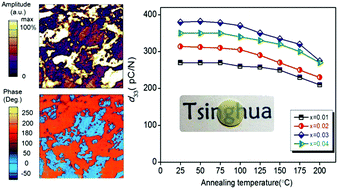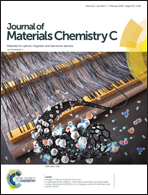Niobate-based lead-free piezoceramics: a diffused phase transition boundary leading to temperature-insensitive high piezoelectric voltage coefficients†
Abstract
One of the key remaining challenges for the most promising Pb-free (K,Na)NbO3 (KNN) piezoelectrics is how to improve the temperature stability of piezoelectric voltage coefficients, which is vital to promoting their practical applications. This study proposes an effective approach to develop highly piezoelectric KNN-based ceramics with temperature-insensitive piezoelectric voltage coefficients (d33), which is also called direct piezo-coefficient, by broadening the boundaries from tetragonal to orthorhombic and then to rhombohedral phases. The Li-doped KNN ceramics modified with BaZrO3 and (Bi,Zr)TiO3 exhibit a high d33 up to 330 pC N−1, whose variation is limited to ±10% in a common application temperature range (25–100 °C), when their composition is optimized for strengthening their temperature stability. A high d33 up to 380 pC N−1 with a larger variation (<20%) but in a wider temperature range (25–200 °C) was also available in the present materials possessing a large planar electromechanical coupling coefficient kp up to 0.54 and a high Curie temperature of >260 °C as well as high strength associated with high relative density. Piezoelectric force microscopy (PFM) studies reveal that the good piezoelectric response could be related to the easier domain reorientation and domain wall motion. The present results validated that our approach based on phase transition boundary engineering should be an effective strategy for further development of high-performance lead-free piezoceramics towards the demand for industrial applications.



 Please wait while we load your content...
Please wait while we load your content...